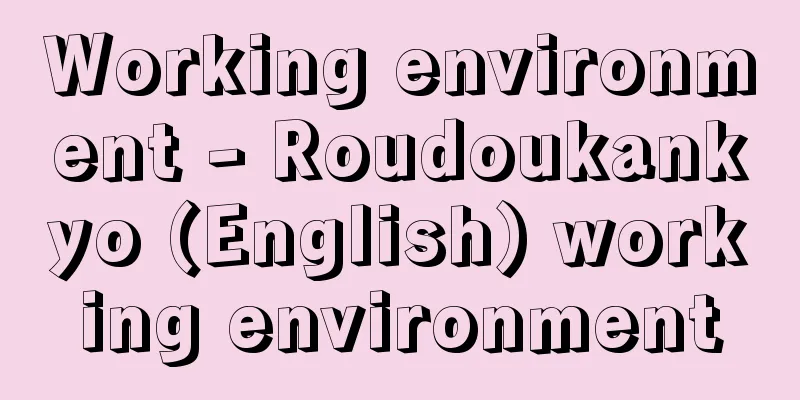Working environment - Roudoukankyo (English) working environment

|
In the narrow sense, it refers to the direct environmental conditions at the place where workers work, and is used almost synonymously with the terms working environment and workplace environment. In the broad sense, it can also include human relationships at the workplace and commuting conditions, but it is generally used to mean the narrow working environment. The factors that make up the working environment can be broadly divided into physical factors (harmful energy that affects workers' health) and chemical factors (chemical properties of harmful substances that affect workers' health). Physical factors include temperature, humidity, radiant heat, air pressure, lighting, noise, ultrasound, local vibration, microwaves, laser beams, infrared rays, ultraviolet rays, and ionizing radiation. Chemical factors include mineral dust that causes pneumoconiosis, various industrial poisonings, organic solvents that cause skin disorders, specific chemicals, and heavy metals, which are absorbed into the body in the form of gas, liquid, or solid through the skin, respiratory system, and mucous membranes of the mouth. When considering the impact of the work environment on workers' health, the following points must be emphasized. In other words, in the long history of human evolution, in a short period of time since the Industrial Revolution, a new and different environmental condition that humans have never experienced before has appeared as a work environment, and therefore it is difficult for living organisms to adapt to the harmfulness of the work environment. Furthermore, the work environment is a condition given to workers by capitalists, and even if the environment is harmful, it can be said that under the current labor-management relationship, there is little freedom for individuals to choose a better environment. For this reason, the work environment is very important in protecting workers' health. If hazardous factors in the work environment are not eliminated or properly controlled, it will have a significant impact on workers' health and safety, and will be a direct or indirect cause of work-related accidents and occupational diseases. In addition to preventing accidents and diseases, it is important to proactively create a comfortable work environment in order to improve the quality of workers' lives. Among the harmful factors in the work environment, there are many that cannot be perceived by the senses, not just those that can be sensed by the five human senses. Furthermore, human senses easily become accustomed to them, and they often cannot be accurately perceived. Therefore, accurate measurement and evaluation of the working environment is necessary as a prerequisite for improving the working environment. In addition to the Industrial Safety and Health Act (Act No. 57 of 1972), relevant laws and regulations include the Pneumoconiosis Act (Act No. 30 of 1960), the Organic Solvent Poisoning Prevention Regulations, the Lead Poisoning Prevention Regulations, the Specific Chemical Substances and Other Harm Prevention Regulations, the Office Hygiene Standards Regulations, and others. There is also the Work Environment Measurement Act (Act No. 28 of 1975), which stipulates the qualifications of measurement organizations and measurement engineers for work environments. [Hiromasa Shigeta] [Reference items] | | | | | |Source: Shogakukan Encyclopedia Nipponica About Encyclopedia Nipponica Information | Legend |
|
狭義には労働者の就業する場所における直接的な環境諸条件をさし、作業環境や職場環境の語とほぼ同義に使われる。広義には職場の人間関係や通勤条件をも含めて用いられることもあるが、一般には狭義の作業環境の意で用いられることが多い。労働環境を構成する要因別にみると、大きく物理的要因(有害エネルギーが労働者の健康に作用するもの)と、化学的要因(有害物質の化学的性質が労働者の健康に影響を与えるもの)とに分けられる。物理的要因には、温度、湿度、放射熱、気圧、照明、騒音、超音波、局所振動、マイクロ波、レーザー光線、赤外線、紫外線、電離放射線などがあげられる。また化学的要因としては、塵肺(じんぱい)症をおこす鉱物性粉塵や、種々の産業中毒、皮膚障害をおこす有機溶剤、特定化学物質、重金属などがあげられるが、これらはガス、液体、固体の形で労働者の皮膚や呼吸器、口腔(こうくう)などの粘膜を介して体内に吸収される。 労働環境が労働者の健康に及ぼす影響を考える際、次の事情が重視されなければならない。つまり、人類進化の長い歴史のなかで、産業革命期以降の短期間に、人類がこれまでに一度も経験したことのない異質な環境条件が労働環境として新たに立ち現れているということ、したがって、労働環境の有害さに対する生物としての順応はむずかしいということである。また働く者にとって労働環境は資本家から与えられた条件であって、たとえ有害な環境といえども、現実の労使関係のもとでは個人的によりよい環境を選択する自由はほとんどないといえる。それだけに、労働者の健康を保護するうえで労働環境のもつ意義は大きい。労働環境における危険有害因子が除去ないしは適切にコントロールされなければ、労働者の健康と安全に重大な影響を及ぼし、労働災害や職業病発生の直接・間接の原因となる。また、災害防止や疾病予防にとどまらず、より積極的に快適な労働環境を形成することは、労働者の生活の質を向上させるうえで重要である。労働環境の有害因子のなかには、人間の五感で感じ取れるものだけでなく、感覚的にとらえることのできないものも少なくない。また人間の感覚には容易に慣れが生じ、正確にとらえられないことも多い。したがって、労働環境改善の前提として正確な環境の測定と評価が必要である。 関連法規としては労働安全衛生法(昭和47年法律57号)のほかに、じん肺法(昭和35年法律30号)、有機溶剤中毒予防規則、鉛中毒予防規則、特定化学物質等障害予防規則、事務所衛生基準規則、その他があり、また作業環境の測定機関や測定士の資格等を定めた作業環境測定法(昭和50年法律28号)もある。 [重田博正] [参照項目] | | | | | |出典 小学館 日本大百科全書(ニッポニカ)日本大百科全書(ニッポニカ)について 情報 | 凡例 |
<<: Labor Relations Adjustment Act
>>: Labor theory of value - labor theory of value
Recommend
President - Gakucho
〘 noun 〙 The head of a university who is in charge...
History of the United States (Channing)
…He studied under Henry Adams at Harvard Universi...
Baekje Records, Baekje New Edition, Baekje Books - Kudara Ki, Kudara Shinsen, Kudara Honki
History of Baekje cited in the notes of the Nihon ...
Law consciousness
The term "legal consciousness" refers co...
Spring and Autumn Period and Warring States Period
A period of change in ancient China from the 8th ...
Food preparation
...The placenta is delivered naturally within abo...
Tokyo Theological University
It is a private institution. In 1943 (Showa 18), ...
Fading - Fading (English spelling)
This is a phenomenon in which the strength of rad...
Ambrosius - Ambrosius (English spelling)
Bishop of Milan. One of the Four Doctors of the W...
Jiang Qi
…? - 379 BC. Also called Jiang Qi to distinguish ...
Mr. Oiwa
…There are precedents for other craftsmen, but in...
The Inspection and Political Affairs Committee
The name of the buffer government between Japan an...
Vein - komyaku (English spelling) vein
A vein is a fissure in a rock that is filled with...
Elatior Begonia - Elatior Begonia
…Since the first variety was announced in 1891, i...
Otomo no Kuronushi
Years of birth and death unknown. A poet of the e...









